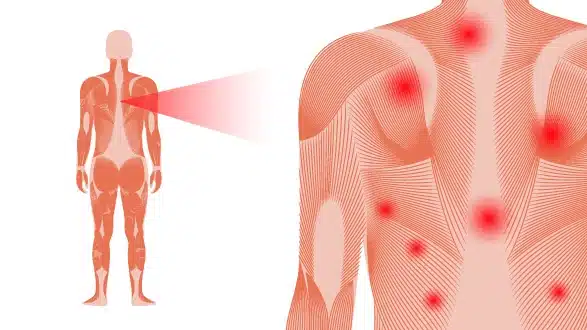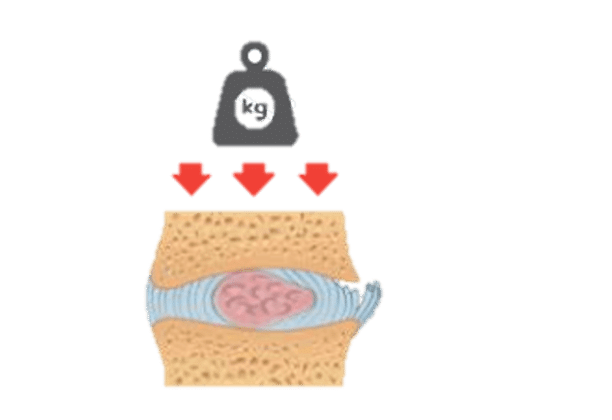Request Appointment
Enter your details and we will be in touch with you shortly;
Or call
8655885566
between 8 am and 8 pm.

A condition that causes intense widespread pain through the bodys musckuloskeletal system including back and neck pain

Fibromyalgia is a chronic, nonspecific somatic syndrome distinguished by increased tenderness in specific body points, fatigue, sleep disorders, and problems with memory. This condition changes how the brain interprets pain signals, improving the perception of the painful experience. Although its exact cause has not been identified, most scholars agree that it implicates hereditary, environmental, and psychological conditions.
Fibromyalgia, also known as fibromyalgia syndrome, is characterized by patients experiencing deep, bone-deep pain, usually from the muscles and connective tissues. This includes joint pain and stiffness, sensitivity to cold, heat, and pressure, and difficulty with memory and concentration, also known as ‘fibro fog’. The condition is more common in women and will markedly interfere with their activities.
Fibromyalgia may evolve from physical trauma, surgery, infection, or severe psychological stress. Occasionally, symptoms arise slowly and work their way up to a climax without the presence of any specific cause. It is a disease resulting from chronic pain management, whereby the nervous system becomes sensitive to pain stimuli.
The condition impacts people's physical and psychological well-being. Pain and fatigue are the two primary symptoms; other symptoms include difficulty sleeping, temper swings, and poor concentration. Fibromyalgia is misdiagnosed because the signs are not noticeable; the muscles do not show any signs of inflammation or injury.
Treating fibromyalgia involves several different disciplines and approaches. Fibromyalgia treatment entails the use of drugs, medication, therapy, and lifestyle changes to try to contain the symptoms.
Acupuncture, yoga, and meditation are some of the beneficial complementary therapies for fibromyalgia. A fibromyalgia patient must regularly do low-impact aerobics or stretching exercises. Fibromyalgia relief treatment has emerged as one approach to stress-free treatment, to improving sleep and muscle function.
Fibromyalgia affects the musculoskeletal system along with connective tissue and often results in muscle stiffness, especially in the neck, shoulders, and back. Some of the other common symptoms of fibromyalgia are:
 Professional diagnosis required
Professional diagnosis required Chronic, can last for years
Chronic, can last for years Treatable with 8 weeks of QI Spine Therapy
Treatable with 8 weeks of QI Spine TherapyFibromyalgia is a chronic disease characterized by widespread musculoskeletal pain, chronic fatigue, and sleeping problems. (Although the exact cause of the disease is yet to be understood entirely), Studies indicate that fibromyalgia may be a result of a mixture of genetic, neurological, and environmental factors. Irregular pain sense, stress-induced changes in hormonal levels, and mood and pain-moderating chemicals’ levels in the brain can all lead to fibromyalgia. These factors might combine and amplify the processing of pain signals by the brain and the spinal cord, resulting in lifelong discomfort.
Patients with fibromyalgia are more sensitive to pain. This is blamed on abnormal levels of some chemicals in the brain that increase pain sensations. The central nervous system can overreact to the body's sensations; even a nice pressure may be perceived as hurtful.
Fibromyalgia is known to be hereditary, which makes one suspect a genetic predisposition. Specific genes can determine how one perceives pain in the brain, making certain individuals more susceptible to pain.
Previously experienced physical traumas or stress-evoking events, such as accidents, abuse, or post-traumatic stress disorder (PTSD), can precipitate fibromyalgia symptoms. Such events can re-train the brain on how it perceives pain.
Some infections or even illnesses are associated with the onset or worsening of fibromyalgia. Viruses, for instance, can attack the nervous system and could prompt symptoms.
Sleep problems are both a symptom and a cause. Poor sleep quality negatively impacts the body's ability to repair itself, causing fatigue and pain.
Due to its complex nature, fibromyalgia treatment often requires a multidisciplinary approach combining medication, physical fibromyalgia therapy, and lifestyle changes. Early understanding of these triggers plays a crucial role in chronic pain management and long-term relief.
 Professional diagnosis required
Professional diagnosis required Chronic, can last for years
Chronic, can last for years Treatable with 4 weeks of QI Spine Therapy
Treatable with 4 weeks of QI Spine TherapyThe commonly prescribed treatments for fibromyalgia are antidepressants, anti-epileptics, muscle relaxants, sleeping tablets, and pain killers. Each of these strong medicines comes with a long list of side effects.
Since there is no cure for fibromyalgia, patients have to stay on these medicines for life, which increases their risk of other health complications. But there are safer alternative therapies for fibromyalgia:
Spine specialists recommend strength training and low-impact aerobic exercises to reduce muscle pain and fatigue. These exercises also improve sleep quality and quantity, which in turn reduces the symptoms of fibromyalgia.
Advanced physiotherapy and medical movements for fibromyalgia focus on stretching exercises, which help prevent muscle stiffness and improve muscle function. Your physiotherapist will track your progress and recommend gradual intensity progression depending on your improvement.
The constant pain from fibromyalgia has a tremendous psychological impact on patients. Anxiety and stress can aggravate fibromyalgia pain, and counselors teach patients stress-control methods, including slow rhythmic movements with deep breathing that promote relaxation.
Fibromyalgia causes widespread muscle aches and pains. Therapeutic massage therapy relieves pain, reduces stress, and relaxes tense muscles. Massage also increases blood circulation to the targeted areas, preventing muscle stiffness.
There are several studies that show that acupuncture is effective in reducing fibromyalgia pain. In acupuncture, very fine needles are used to stimulate certain areas and bring about changes in the levels of the neurotransmitters in the brain and spinal cord, which in turn reduce pain.
If you have trouble with simple cognitive or memory tasks, please consult a QI Spine’s spine specialist to rule out other possible complications.
Since the management of fibromyalgia, primarily due to the severity, demands much more than medications and in-clinic therapies, it requires an everyday life change that promotes health in general and reduces flares.
Set up a good night’s rest, 7-9 hours, by having the same bedtime, reducing time spent on screens before sleep, and having a tranquil, dark space. Good sleep underpins effective fibromyalgia relief therapy, as restorative rest helps modulate pain and fatigue.
Include daily relaxation practices like deep breathing, progressive muscle relaxation, or even mindfulness meditation in one’s life to reduce anxiety and break the cycle of stress-induced pain amplification. Continuous breaks throughout the day may prevent overwhelm.
Focus on whole, nutrient-dense foods: colored fruits and vegetables, oily fish with plenty of omega-3s, lean protein sources, and food sources made of whole grains. Use of coconut oil, olive oil, butter, and ghee. Whole grains, whole fruits, and non-starchy vegetables. Give up processed sugars, carbohydrates, and excess caffeine, which may intensify pain and make your brain fuzzy.
Improve your daily water intake and avoid alcohol and sugary drinks. Correct hydration lubricates and loosens muscles and improves clarity of mind.
Alternate activity with rest-time to prevent the “boom–bust” cycle of overdoing it every good day and crashing for every bad day. Use a daily planner to spend equal time on tasks, exercise, and relaxation.
Maintain contact with friends, family members, or support groups that understand fibromyalgia. Emotional support reduces isolation and increases resilience.
By integrating these lifestyle changes alongside professional fibromyalgia therapy, individuals can achieve more consistent symptom control, enhanced functionality, and a better quality of life.
The therapeutic effects of water are based on the peculiar character of the substance:
Immersion and aquatic exercise enhance musculoskeletal function, neuromuscular control, and cardiovascular capacity. Better respiratory mechanics while under hydrostatic pressure, together with modulation of neuroendocrine pathways (e.g., release of endorphins), help to enhance analgesia and decrease inflammation.
Randomized controlled trials (Altan et al, 2004; Andrade et al, 2018) indicate that pain (visual analog and tender-point scales), fatigue, morning stiffness, and depression are tremendously reduced alongside some improvement in muscle endurance, sleep quality, and general health-related quality of life. Passive balneotherapy may show shorter-lasting effects than aquatic exercise.
With its low cost, availability, and relatively greater safety profile, water therapy is highly recommended alongside land-based exercises in FMS management. Future research should compare its findings with other modalities for long-term efficacy, the specific neurophysiological mechanisms, and economic effects for clinical guidelines optimization.
 Professional diagnosis required
Professional diagnosis required Chronic, can last for years
Chronic, can last for years Treatable with 4 weeks of QI Spine Therapy
Treatable with 4 weeks of QI Spine TherapyThe commonly prescribed treatments for fibromyalgia are antidepressants, anti-epileptics, muscle relaxants, sleeping tablets, and pain killers. Each of these strong medicines comes with a long list of side effects.
Since there is no cure for fibromyalgia, patients have to stay on these medicines for life which increases their risk of other health complications. But there are safer alternative therapies for fibromyalgia:
Spine specialists will recommend strength training and low-impact aerobic exercises to reduce muscle pain and fatigue. These exercises will also improve sleep quality and quantity which in turn reduces the symptoms of fibromyalgia.
Advanced physiotherapy and medical movements for fibromyalgia focus on stretching exercises as this helps to prevent muscle stiffness and improves muscle function. Your physiotherapist will track your progress and recommend gradual intensity progression depending on your improvement.
The constant pain from fibromyalgia has a tremendous psychological impact on patients. Anxiety and stress can aggravate fibromyalgia pain and counselors teach patients stress-control methods including slow rhythmic movements with deep breathing that promote relaxation.
Fibromyalgia causes widespread muscle aches and pains. Therapeutic massage therapy relieves pain, reduces stress, and relaxes tense muscles. Massage also increases blood circulation to the targeted areas which in turn prevents muscle stiffness.
There are several studies that show that acupuncture is effective in reducing fibromyalgia pain. In acupuncture, very fine needles are used to stimulate certain areas and bring about changes in the levels of the neurotransmitters in the brain and spinal cord which in turn reduces pain.
If you have trouble with simple cognitive or memory tasks, please consult a spine specialist to rule out other possible complications.
 Professional diagnosis required
Professional diagnosis required Chronic, can last for years
Chronic, can last for years Treatable with 4 weeks of QI Spine Therapy
Treatable with 4 weeks of QI Spine TherapyTo diagnose fibromyalgia, a comprehensive evaluation is required because no one laboratory test is diagnostic for fibromyalgia. Clinicians follow a structured approach:
Once fibromyalgia is diagnosed, care focuses on fibromyalgia relief therapy, including exercise programs and sleep hygiene, with agents like low-dose antidepressants or anticonvulsants. Integrating chronic pain management techniques, such as cognitive behavioral therapy, helps patients regain function and quality of life.
 Professional diagnosis required
Professional diagnosis required Chronic, can last for years
Chronic, can last for years Treatable with 4 weeks of QI Spine Therapy
Treatable with 4 weeks of QI Spine Therapy


Have a question?
Ask our spine specialists
Who is a QI Spine Specialist?
A QI Spine Specialist is a medical expert with

Dr. Nidhi Sanghvi Shah

Dr. Shital Gaikwad

Dr. Richa Bhatia
9000 hours
of specialisation in treating back and neck conditions
32 hours
of spine physiotherapy specialisation methods in McKenzie concepts, Kinetic control, Neurodynamic solutions, Mulligan’s concepts
500 hours
and 6 months of QI Spine specialisation courses
Although vitamin D deficiency is unlikely to be the only cause of fibromyalgia, it can aggravate other problems, such as muscle pain and fatigue, which are common symptoms found in fibromyalgia patients.
Fibromyalgia affects the whole body, not a specific organ. It disrupts how the brain and nervous system interpret pain signals, making it part of the treatment for pain syndrome therapy conditions.
Fibromyalgia is an acknowledged neurological syndrome that messes with the central nervous system and the processing of pain signals.
Fibromyalgia doesn’t originate in the bones or muscles but causes widespread muscle tenderness, which often leads to the need for muscle pain treatment.
The age group for a diagnosis of fibromyalgia is 30 – 60, but signs of the illness can be found in younger people or those with any history of stress or trauma.
Absolutely. Fibromyalgia is a long-term condition, but with the proper fibromyalgia treatment and chronic pain management, individuals can live a whole life.
Symptoms are relatively mild at the onset phase, also known as Stage 1, and frequently consist of lingering fatigue and isolated pain. Early intervention through fibromyalgia therapy can improve long-term outcomes.